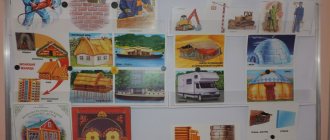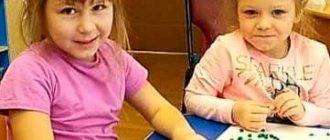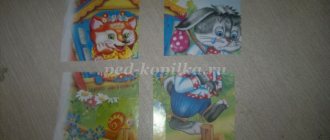Complex lesson “The Three Little Pigs”
Municipal state preschool educational institution
Izobilnensky municipal district of the Stavropol Territory
"Combined kindergarten No. 1"
“ Comprehensive
lesson
for older children”
Subject:
Izobilny town. 2016
Purpose of the lesson
: stimulate children's speech activity.
Tasks:
- Continue teaching children to retell a fragment of a fairy tale using a model (substitute objects).
- Continue to develop skills in non-traditional drawing techniques.
- Bring up skill
emotionally perceive and convey the mood of the character.
- develop fine motor skills using speech accompaniment
Preliminary work:
- Reading the fairy tale “The Three Little Pigs.”
- game “The Three Little Pigs” (game with cards - substitute models)
Material:
- Three rectangles (yellow, brown, orange).
- Houses for piglets or a toy pig.
- For drawing a house blank (sponge, gouache).
Work order
I. Creating motivation
.
A song from the cartoon “The Three Little Pigs” sounds
Guys, did you recognize the fairy tale “The Three Little Pigs”? Who remembers the names of the heroes of this fairy tale? (children's answers). Well done, you got their names right. Let's take a journey into this wonderful fairy tale today. Let's stand in a circle, hold hands tightly and say the magic words:
Get into the circle quickly
Hold hands tightly
One two three four five
Let's start the story
In a fairy tale, we will go along a magical path to a fairy forest where three little pigs live. (hardening track)
Go with the children to the carpet.
Look what I found in the forest (I show the children a basket in which there are acorns and dummies of mushrooms, covered with a napkin). Let's help the piglets collect mushrooms so that they do not get poisoned.
GAME “Edible, not edible”
-Well done boys. They correctly helped the piglets collect mushrooms and acorns for lunch.
All summer the piglets frolicked and had fun. But then autumn arrived. It became cold, and Naf-Naf said that it was time to think about winter. He suggested that everyone build a warm and durable house together so as not to catch a cold and not fall into the clutches of the gray wolf.
But Nif-Nif and Nuf-Nuf continued to have fun, singing a boastful song. Who remembers her words?
- Whose song is this? (Song of the Three Little Pigs.)
The children all sing a song together: “We are not afraid of the gray wolf...”.
But then autumn came. Every day it became colder and colder. And our piglets decided to build themselves houses.
II Working with substitute models.
The teacher takes cards with images of houses and fairy tale characters, shows them to the children and asks them to pay attention to the fact that the images on the cards differ in color.
Game “Guess” (children guess the names of the piglets and where whose house is)
Need a house for three friends
To keep them warmer.
We quickly got down to business
They build deftly and skillfully.
And only when in the morning the puddles began to be covered with a thin crust of ice, the lazy brothers got to work.
-Let's try to build a house together with the piglets.
Nif-Nif decided to build the simplest house. Of what?
Nuf-Nuf decided to build a wicked house. Of what?
Both, satisfied with their work, went to see how things were going with Naf-Naf. The piglets were surprised that Naf-Naf's house looked like a stone fortress. And Naf-Naf continued to finish building his house and hummed a cheerful song. (Offer to sing a funny song “We are not afraid of the gray wolf...” and dance).
III
Practical work
House of Naf-Naf (painting with a sponge (bricks)
Physical exercise: “Song of the piglets”
Piglet
This fat piglet was wagging his tail all day This fat piglet was scratching his back on the fence This fat piglet was picking up the ground with his nose This fat piglet drew something himself This fat piglet was a couch potato and impudent He wanted to sleep in the middle and pushed all his brothers out of the way
Take turns stroking your baby's fingers, first the little and ring fingers, then the middle and index fingers.
The piglets had a rest and had fun. What happened next? Who did the wolf come to first? (Nif-Nif) The wolf began to blow on the straw house, and it shattered. Nif-Nif dodged the wolf and ran to Nuf-Nuf's house. What happened next? Correctly, both piglets hid in a house made of twigs, but even here the wolf did not leave them alone. You will find out how many times the wolf had to blow to destroy Nuf-Nuf's house if you count the sounds of the metallophone. (knock 7 times).
And now we will try to blow like a wolf on Naf-Naf’s house.
(Sound, breathing exercises)
Do you think we will be able to destroy Naf-Naf's house? What happened next? (Children, with the help of the teacher, tell the story to the end.) The wolf ran into the forest, and the three piglets began to live together in Naf-Naf’s house.
Get into the circle quickly
Hold hands tightly
One two three four five
We will close the story.
IV Reflection.
Did you like traveling through a fairy tale?
If you are in a good mood right now, please smile!
Notes on “The Three Little Pigs” outline of a lesson in mathematics (junior group) on the topic
Summary of continuous educational
integrated activities
in the second junior group "Luchiki"
on the topic: “The Three Little Pigs”
Prepared and conducted:
Olefirenko Lyudmila Alexandrovna
Goal: To promote the development of cognitive abilities and observation.
Tasks:
- achieve clarification of knowledge about primary colors;
- develop the ability to count within three, name numbers in order;
- ensure recognition of geometric shapes in a gaming environment;
- activate children's speech;
- promote a friendly attitude towards each other.
Integration of educational areas: social-communicative, cognitive, artistic and aesthetic.
Types of children's activities: gaming, communicative, cognitive-research, artistic (application).
Equipment and materials: projector (illustrations for the fairy tale “The Three Little Pigs”); puppet theater character (wolf); paper figures of three little pigs; fragments of pictures “houses”; cardboard; glue; brushes, wet wipes.
Preliminary work:
- reading the fairy tale “The Three Little Pigs”;
- counting from 1 to 3;
- didactic games: “match by color”, “what shapes are there”;
- observing seasonal changes in spring while walking.
Node progress:
- Organizing time
Q: Guys, look who came to visit us? (children's answers)
Piglet: - I was walking and got lost, please help me return to my fairy tale.
Q: – What kind of fairy tales about piglets do you know? (children's answers)
- Now I’ll tell you a riddle, and you guess what fairy tale he’s from.
- Mystery
Who didn’t want to work, but played and sang songs?
Then they ran to brother three to their new house!
We escaped from the cunning wolf, but our tails shook for a long time!
The fairy tale is known to any child and is called ... (children's answers)
- Conversation
Q: – That’s right, this is the fairy tale “The Three Little Pigs.”
Children are shown an illustration of three little pigs.
Q: – Let’s remember what the piglets’ names were? (NIF-NIF, NUF-NUF and NAF-NAF)
– What did the piglets decide to build? (children's answers) How many houses?
Children are shown an illustration depicting three houses.
Q: – What happened next? Who were the piglets afraid of? (children's answers)
What did the wolf do? (children's answers)
Children are shown an illustration of a wolf blowing on houses.
Q: – Which house couldn’t the wolf destroy? (children's answers)
Children are shown an illustration depicting a house and three happy piglets.
Q: – So you and I remembered the fairy tale, and now I invite you to play a little.
- Physical education lesson (Children perform movements according to the text)
Three plump piglets come to visit us. (walking in place)
Three clever little pigs play in the morning. (jumping on two legs in place)
Three fast little pigs run, run, run. (running in place)
Three nice little pigs dance and sing. (children clap their hands)
- Game: “Make a picture”
A wolf (toy) appears.
Wolf: - R-rr-r-r
Q: Guys, who is this? (children's answers)
Wolf: Who is that making so much noise? A! These are piglets! Again they are having fun and preventing me from sleeping!
Q: - Guys, in the fairy tale, where did the piglets run? (children's answers)
– How can we help the piglets hide? (children's answers)
- Yes, we will help them build houses.
The teacher invites you to sit on the chairs where there are fragments of pictures on the table.
Q: Guys, how many houses were there in the fairy tale? (children's answers)
- That's right, three. Who knows what they were built from? (children's answers)
- A house made of straw. - House made of branches. - A house made of bricks.
Q: Guys, what figures do you see on the table? (children's answers)
– What figure should you take to build a house? (square)
– What figure do you need to take to build a roof? (triangle)
- Then there will be a window? (circle)
Children are divided into three subgroups. Task: collect pictures of three different houses.
Q: - What a great fellow we are, we helped the piglets. And now, each piglet will hide in his own house.
- Game “Help the piglets find their home”
Q: – What color is the clothes of the piglet Nif-Nif? (yellow) He really likes this color. That's why he lives in a house with a window, what color? (yellow)
– What color is the clothes of the pig Nuf-Nuf? (green) He really likes this color. That's why he lives in a house with a window, what color? (green)
– What color is Naf-Naf the pig’s clothes? (red) He really likes this color. That's why he lives in a house with a window, what color? (red)
Q: – Thank you, the guys helped the piglets find their home.
- Breathing exercises
Q: – What was the first house destroyed by a wolf? How did he do it? (children's answers)
Let's blow like a wolf together, inhale air through our nose and exhale through our mouth! Now with me! (children blow on a straw house).
- Why did the house collapse? (children's answers)
Q: – Which second house was destroyed by the wolf? (children's answers)
– Once will not be enough, you need to blow twice (children blow on a house made of branches). What happened to the house? What was the house like? (children's answers)
Q: – Did the wolf break the third house in the fairy tale? Why didn't the wolf succeed? (children's answers)
- Application
Q: - Come on, and we will make this house strong, durable and reliable. Take your brushes and use glue to glue the house and our three little pigs onto this sheet.
Q: - Guys, do you like the house we have? (children's answers)
- Bottom line
Q: Guys, who did we help today? (children's answers)
– Who else did we help? (children's answers)
– How did we help them? How many houses have we built? (children's answers)
-What did the wolf do? Which house turned out to be the strongest? (children's answers)
Q: – Look how great you are! Now the piglets are not afraid of the gray wolf. Look how happy they are.
Methodical instructions. Game situation "The Three Little Pigs".
Game situation "The Three Little Pigs".
Part I. The teacher sings a song to the piglets:
We are not afraid of the gray wolf, Gray wolf, gray wolf! Where do you go, stupid wolf, Old wolf, dire wolf?
Clarifies who sang this song and what fairy tale it is from.
The teacher attaches pictures of three piglets to the flannelgraph and, together with the children, remembers their names.
The teacher asks the children what needs to be done to find out how many piglets there are. Reminds children how to count piglets, how to make a generalizing gesture and say “only three piglets.”
The teacher calls the children one by one and asks them to count the piglets. Then he offers to treat the piglets with acorns. The children give each piglet one acorn. The teacher counts acorns together with the children. Based on the count, the guys are convinced that the piglets and acorns are equal.
Part II. The teacher shows the children the piglets' houses and suggests making doors of the required width to close the entrance to the houses.
The guys decide how wide the doors should be, compare them by width and select a door for each house.
Part III. There are paper tracks on the children's tables.
The teacher gives tasks: “What can you say about the length of the paths? Compare them by length. Which path will the piglet take to get to the house faster? (Short version.)
Show me the shortcut."
In the same way, children choose a tall Christmas tree from two Christmas trees to hide the pig’s house behind it.
Physical education minute
Children stand in a circle and first show a high Christmas tree (they rise on their toes and stretch their arms up), then a low Christmas tree (they squat down).
The exercise is repeated 2-3 times.
Part IV. Together with the children, the teacher looks at plot pictures depicting piglets at different times of the day. He clarifies what time of day is shown in the picture, asks the children to justify their conclusion and places the cards in order (morning, afternoon, evening, night).
Lesson 4
Program content
• Continue to learn to count within 3, correlating a number with an element of a set, independently designate the final number, and correctly answer the question “How much?”
• Improve the ability to distinguish and name geometric shapes (circle, square, triangle) regardless of their size.
• Develop the ability to determine spatial direction from oneself: above, below, in front, behind, left, right
.
Didactic visual material
Demonstration material.
Flannelograph, 3 bunnies, 3 carrots, circle, square, triangle, tray, bell.
Handout.
Two-page card, 3 squirrels, 3 nuts; circle, square, triangle (one shape for a child).


